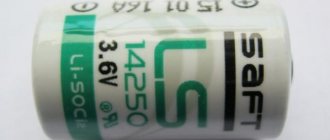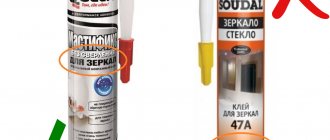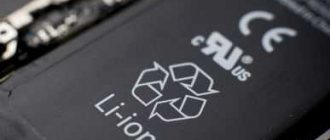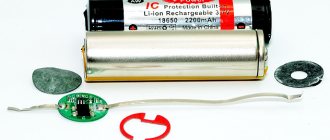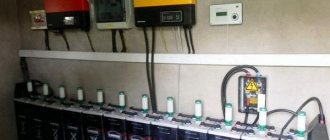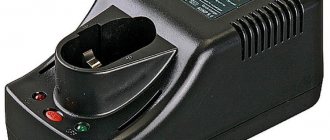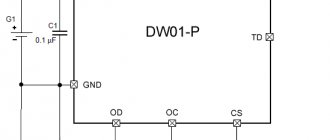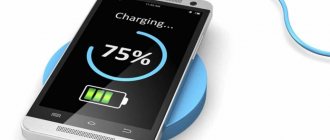For decades, acid batteries were considered devices that ensured the operation of various types of mechanisms and autonomous objects.
Despite many advantages, such batteries also had disadvantages: they could not be used in devices with high electricity consumption. Also, use in closed, unventilated areas was not allowed.
But time does not stand still, and something new always replaces the old. So little by little, lithium-ion (Li-Ion) batteries emerged. They have become better quality than their predecessors, and therefore more reliable.
Having some defects, they have a minimum of negative qualities. Details below.
All (+) and (-) lithium-ion batteries
In the 70th year of the last century, Li-ion batteries became known.
To increase the level of electricity, a lithium anode was installed in such a battery. Thanks to it, the operation of the product increased, but another problem arose: if the cathode overheated, the battery could ignite.
After a certain period of time, this defect was replaced by metal ions, significantly reducing the risk of battery fire.
Lithium-ion batteries are still very popular among buyers. They have been tested by time, the number of charges/discharges per cycle is numerous.
Possessing a weak “memory effect” and light weight, li-Ion batteries find their usefulness in many portable and stand-alone devices. For example, li-ion batteries for household appliances, sources for traction of electricity with high efficiency.
Lithium-ion batteries also have their own shortcomings, which, in principle, can be easily compensated for by the ability to store energy, thanks to their high density.
Let's list some of them:
- relatively expensive;
- prolonged discharges are detrimental to them;
- work worse in hot weather;
- at temperatures with a minus sign they can disappear (“die”);
- if the seal is broken, they become explosive;
- They lose capacity both when overheated and when used in cold conditions.
Battery operation stages
Like every electronic device, power supplies have their own life path. In order for them to serve as long as possible without the need for replacement, you need to follow the rules of correct operation at each stage. There are several of them:
- Primary charge-discharge cycle.
- Everyday use.
- Storage.
- Disposal.
When delivered to the user, the battery should be subjected to several consecutive full discharges and charges.
This way you can configure the controller internally to optimal parameters and significantly extend the service life. To do this, without recharging, you need to completely lower the charge level to a value close to zero, and then charge it. It is better to repeat this process no more than three or four times. In subsequent cases, the battery will only be harmed. In everyday work, it is better not to allow the level to drop below fifteen to twenty percent. When charging, do not leave the device connected to the network overnight. Then the battery is under constant standby voltage, which reduces its life cycle time.
Using low-quality chargers can also greatly reduce the life of the battery. In their manufacture, low-quality electrical materials are used, which leads to a discrepancy between the specified characteristics and the real ones.
For example, if the voltage supplied by the charger exceeds the norm by at least 5%, a gradual loss of capacity is inevitable. The same applies to the current supplied to the modules. You can check these parameters with any multimeter. To do this, the charger is inserted into the socket, and the probes of the measuring device are applied to the positive and negative pins at its end.
The measuring device must be set to a mode of up to 20 volts with a switch on the body. If the result is within normal limits, then there is no need to worry. In other situations - for example, when the stated 5 volts produce 5.1-5.2, it is better not to use such a device. This will inevitably cause the battery to degrade its capacity.
There is no need to correctly determine the polarity of the pins on the charger connector: even if it is reversed, the value with a minus sign will simply appear on the screen. It is their search that can cause more problems. In order to accurately determine the two pins responsible for power supply, you need to switch to the “dialer” mode, that is, measuring resistance with a signal during a short circuit. You need to go through all the pins sequentially: the pair at which the multimeter makes a squeak is the desired contacts.
We recommend: How to determine where the plus and minus are on a 18650 Li-Ion battery
Production of lithium-ion batteries
The principle of manufacturing Li-Ion batteries occurs in stages:
- first, electrodes are made;
- they are then combined into a battery;
- then the board and protection are installed;
- then the battery is placed in the case;
- electrolyte is poured;
- The battery is tested and sent for charging.
In order for the product to become of incredibly high quality and not subsequently fail in its performance, it is necessary to strictly adhere to all stages of the production technology, and also not to forget about safety precautions during the work process.
The (-) electrode in a Li-ION battery is foil, the surface of which is coated with a Li substance.
Depending on the purpose for which the Li-ion battery is intended, it will contain the following Li-Ion connections:
In “finger (AA)” and “little finger (AAA)” batteries, the cathode (-) is in the form of a roll and separated from the anode (+) using a separator.
With a large area of the negative electrode covered with a thin film, the energy capacity of the battery becomes significantly higher.
Storage Features
It is no secret that almost all lithium batteries are subject to constant degradation. This irreversible process begins immediately when the battery is removed from the assembly line. Over a year of hard work, the battery capacity can decrease by up to ten percent, given non-compliance with basic rules of operation and storage.
The intensity of degradation is determined by many factors, including the degree of charge and the temperature of the OS.
If you allow the temperature to rise to 40-50 degrees Celsius, then the degradation will be incredibly fast. The most optimal operating mode is 0−10 degrees. However, finding such indicators in a home environment is problematic. Therefore, it is best to store equipment at room temperature and at medium charge.
It is also important to avoid direct sunlight on the battery, and deep discharge and charge the battery every six months.
Given the specific design, you should not disassemble the battery yourself and try to restore it. Only with the appropriate skills and experience can such work be performed. However, it is important to remember safety precautions and remember to use gloves and safety glasses.
Proper care of lithium batteries is the key to their long and reliable operation.
How they work and what is inside lithium-ion batteries
The working activity of a Li-ion battery is as follows:
- Is electric current being supplied to the battery contacts? and lithium cations begin to move towards the electrode (+);
- When the battery begins to discharge, lithium ions leave the electrode (+) and move into the dielectric to a depth of up to fifty nanometers.
The number of such cycles for batteries of this type can be up to three thousand. And in each of them, the rechargeable battery can release almost all the electric current that was accumulated during charging.
Types, sizes of lithium-ion batteries
Lithium-ion batteries are widely used in various household devices, electric cars, tablets and other types of modern gadgets.
There are also industrial Li-Ion batteries with high capacity and high voltage. Below in the table we give examples of batteries that are more in demand on the market:
In addition to cylinder-shaped batteries, there are other product shapes. These include: “Krona” with U=9 Volt and more powerful industrial batteries with U=12 V, U=24 V, U=36 V, U=48 V.
The markings on the battery case indicate the elements that are added to the battery.
For example:
- if it reads ICR, it means the battery contains cobalt;
- IMR marking means the addition of manganese to the composition;
- INR - talks about nickel with manganese in the battery;
- NCR - notifies about a “portion” of nickel and cobalt in the battery.
It is not only the size and chemical additives that distinguish lithium-ion batteries from each other, but also the voltage capacity. They help determine for which electrical device the battery is made.
Aging
Aging of lithium-ion batteries is caused by oxidation of the elements. They lose the ability to accumulate lithium ions necessary for the flow of electricity. Cellular oxidation is influenced by various factors. For example, temperature and battery charge status. Element oxidation occurs especially quickly at high temperatures and when the battery is fully charged. This often occurs with laptops when the battery is fully charged, and at the same time the device is running and actively heating up.
If you want to use a lithium-ion battery for a long time, you should charge it a little more than halfway. The optimal charge level is between 50% and 80%.
If a lithium-ion battery is to be stored for a long period of time, the charge level must be checked regularly. Lithium-ion batteries should be charged every 3-4 months to avoid completely draining them. If the voltage in the cell is below 2 volts, it may be destroyed.
Battery care
Chemical changes in the electrolyte and oxidation of the electrodes are the main causes of aging. Lithium-ion batteries lose capacity after 2-3 years. Careful handling increases the life of the lithium battery:
- Avoid temperatures above 40 C;
- Avoid full charging and discharging;
- Charge the battery to no more than 90 percent of its capacity.
If you handle the battery with due care, its service life can be extended from 3 to 4-5 years.
Application of Li-ION batteries
Lithium-ion batteries are indispensable where there is a need to fully release electricity from a battery, with a considerable number of cycles (charge/discharge), without reducing the capacity of the product.
The advantage is the significantly light weight of the battery. This means that such a device will not require the use of lead gratings.
Having carefully studied all the (+) and (-) aspects of the operation of lithium-ion batteries, we will consider the scope of their application:
- In starter batteries. Li-Ion batteries are becoming cheaper at a rapid rate. All this happens because more advanced batteries are being released on the market every day. They are the main source of reduction in the price of their predecessors. The cost of new products is usually high (which hits hard on the pockets of those who like to travel with the wind). The main drawback of lithium-ion batteries is the drop in power at t˂20, as a result of which their use in the Far North becomes impractical.
- For traction devices. Lithium-ion batteries tend to tolerate deep discharge, so using them as a source of traction for an electric motor in a boat would be appropriate. With a low engine power, one charge of this battery will last for at least six hours of fishing (or a simple boat trip). Li-ION batteries are used for loading equipment that is used in enclosed spaces (for example, for electric stackers, electric forklifts).
- For equipment used in everyday life. Many household devices use lithium-ion batteries instead of traditional batteries. Such batteries have U=3.6 Volts (3.7 Volts). However, there are also those that can easily replace even a salt or alkaline battery with U=1.5 Volts.
And if we consider models with U=3 Volts, for example, “15270” or “CR2”, then this type of battery can replace two standard batteries. Such batteries are usually used in more powerful electrical appliances, that is, where a simple salt battery cannot replace them (due to rapid discharge).
How to protect a Li-ion battery by storing it?
Before storing a lithium-ion battery, you must follow some consistent rules and points:
- Rule 1. A non-humid and non-hot place is the best method for storing batteries.
- Rule 2. Remove the battery from the electrical appliance.
- Rule 3. Be sure to charge the product before storing it. To prevent corrosion of the elements inside, the minimum U = 2.5 V per element.
The self-discharge of lithium-ion batteries is low, so you don’t have to worry about storing them for many years. However, it should be remembered that the capacity of the product will also gradually decrease.
Characteristics
The operation of a lithium-ion battery is based on its technical parameters. The main characteristics of batteries of this type include:
- Energy density - measured in Wh/kg; for lithium-ion batteries, most often it ranges from 90 to 120.
- Specific power - determines the amount of energy per unit of weight, is about 1 - 1.8 kW / kg.
- Self-discharge percentage - determines the amount of energy wasted by the battery over a period of time. For lithium-ion models it is 2 – 3% per month. If the battery is at room temperature, self-discharge is only 7% per year.
- The permissible temperature range for lithium-ion batteries is most often from -30 to +50°C, but in some models it can vary from -60 to +70°C.
- Number of cycles - indicates a quantitative expression for the possibility of discharge and subsequent charging before the lithium-ion battery fails. Depending on the model and design features, it ranges from 2 to 5 thousand cycles. And at 0.5 - 1 thousand, as a rule, about 20% of the initial capacity is lost.
- Minimum and maximum voltage - for lithium-ion batteries, the lowest value is in the range of 2.2 - 2.5V, and the highest is 4.25 - 4.35V.
- Charging time - at optimal mode is about 2 - 4 hours.
Recycling lithium-ion batteries
Li-Ion batteries contain substances harmful to life, so you shouldn’t even try to disassemble them at home. When the battery has reached the end of its service life, it must be disposed of.
For this purpose, there are special collection points for the collection of expired or unusable batteries. For such a service you can receive a monetary reward.
And this is not fantasy! Any lithium-ion product contains an expensive element, which, after processing, will come to life and will continue to be used at work.


